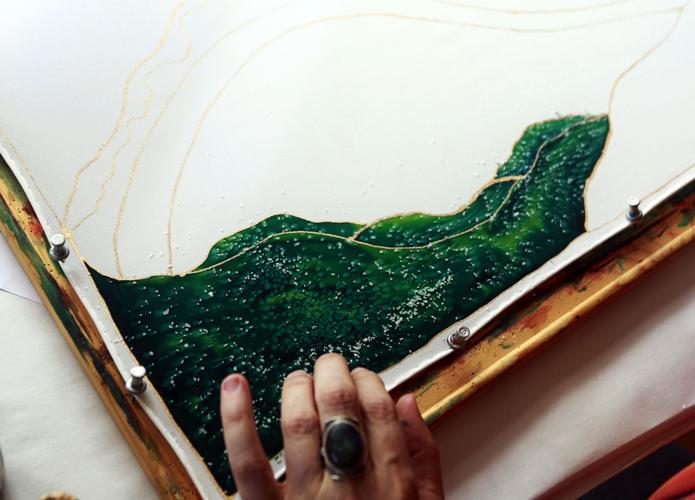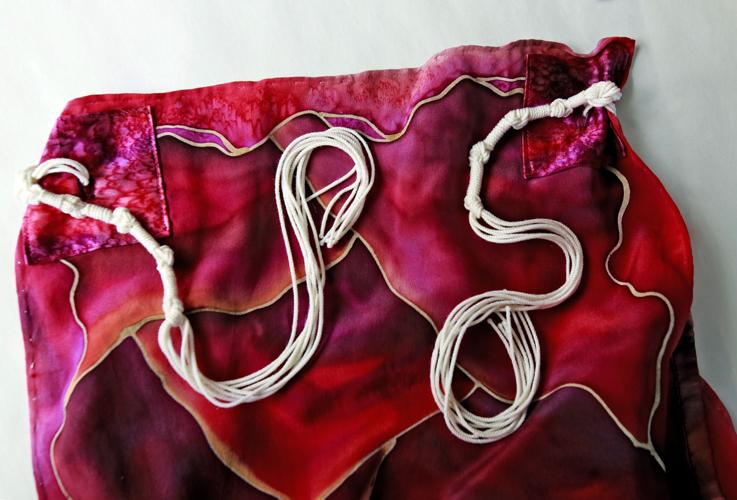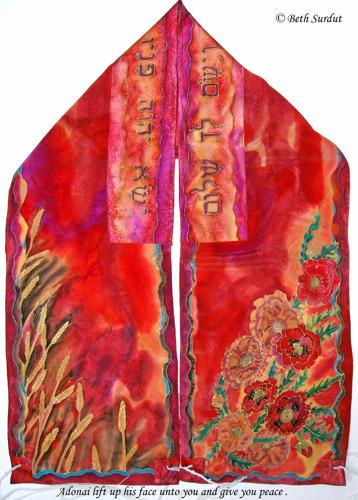When Beth Surdut dons her prayer shawl, she wraps around her shoulders a silk garment inspired by Rosh Hashanahh, the Jewish new year.
The holiday’s start at sunset on Sunday, Sept. 13 begins the High Holy Days of Rosh Hashanah and Yom Kippur, the Day of Atonement. Rosh Hashanahh lasts through Tuesday, Sept. 15. For Jews, this is a time of reflection, with Rosh Hashanah commemorating the creation of the world and Yom Kippur reflecting on repentance and forgiveness.
Surdut, raised in an artistic, Jewish home, began mulling the idea of creating her own prayer shawl — or “tallit” in Hebrew — about six years ago.
To celebrate the new year, she made a silk scarf with a pomegranate on it “to symbolize a fruitful year,” said Surdut. “There is also a story that there are 613 seeds in a pomegranate, which stands for the 613 mitzvot, or laws to live by.”
The scarf sparked her creativity. If she had made this scarf, why not a silk prayer shawl?
Traditionally, Jewish men would wear a prayer shawl during morning prayers and during all prayers on Yom Kippur, which begins sunset on Tuesday, Sept. 22 and ends at dark on Wednesday, Sept. 23. Who wears a prayer shawl differs among congregations, with some sticking to traditional practices and others more open to women donning the garment.
“On one level, the prayer shawl is a very mystical garment, and when you put it on, it puts you into a spiritual place,” said Avraham Alpert, the cantor at Congregation Bet Shalom. “It creates a spiritual and physical space where you’re separate and can turn inward and focus and not be distracted. Maybe people feel God’s presence wrapped around them.”
At Congregation Bet Shalom, anyone who leads part of a service puts on a prayer shawl. In some Jewish traditions, men wear prayers shawls after marriage. In others, children receive the garment at bar and bat mitzvah age, Alpert said.
Because Congregation Bet Shalom so frequently has children lead, Surdut plans to design a shawl for kid participants who haven’t yet reached that age.
Beyond the prayers shawls, Surdut’s portfolio bursts with a variety of work — intricate illustrations, creative nonfiction, stained glass, painted silk, freelance writing and an occasional radio show with Arizona Public Media on the natural world called ”The Art of Paying Attention.” (Her next show airs Oct. 9.) The Tucson Botanical Gardens will also be displaying some of her work in February, she said.
“It’s all so personal, especially as a creative person,” said Surdut, who calls herself a visual storyteller. “It comes from the life we have lived.”
Surdut moved to Tucson in March, wooed to the city initially by the Tucson Festival of Books, where she won the 2013 Literary Award for Nonfiction for her illustrated work “Listening to Raven.” She has traveled the world and lived across the country, growing up Rhode Island, making stained glass in Washington, D.C. and designing Aloha shirts in Hawaii.
Most recently, she lived in Santa Fe, where she began weaving together her faith and art through prayer shawls, healing scarves and Torah covers.
The prayer shawls tell stories, with drawings, colors and symbols representing something significant to the wearer of the garment.
“In Judaism, there is a prayer for appreciating just about everything you can think of,” she said.
The healing scarves offer prayers in times of sickness and crisis. On one morning, she woke with the feeling that she needed to make a scarf but had no specific person in mind. When she turned on the news, she learned that then U.S. Rep. Gabrielle Giffords and 18 others had been shot at a Tucson shopping center, six of them fatally. Surdut made a scarf and sent it to Tucson through her connections in the Jewish community.
Myrna Bernard, who now lives in Santa Barbara, California, met Surdut at the Jewish congregation HaMakom in Santa Fe. Bernard was the first one to request a healing scarf for a friend who had lost her hair because of breast cancer treatment.
She would also commission two prayer shawls — one for an old friend and another for herself.
For Bernard’s friend, an avid gardener, Surdut designed a prayer shawl in vibrant reds, pinks and oranges, with poppies and wheat. For Bernard, who loves the ocean, cool blues streak the garment.
Nan Rubin, who attends the local Congregation M’kor Hayim, wanted a prayer shawl that reflected her love of the mountains and a theme of seeking. She cried when she saw the finished work.
“I sat with Beth for several hours, and I talked about my own religious and spiritual journey and what has meaning for me now in Judaism,” said Rubin, who does not wear her prayer shawl through the year but will during the High Holidays. “My shawl in particular represents a thirst for faith and discovering what God means to me.”
The most traditional prayer shawls are made of wool, with rabbinic opinions differing on guidelines. All prayer shawls must have four corners and “tzitzit,” or fringes on each corner. Many prayer shawls also have an “atarah,” which is like a collar. This is where Surdut writes personal prayers.
“It’s a commandment in the Torah that we have to put these fringe on the corners of the garment, and the fringes remind us of God’s commandments,” Alpert said. “We have 613. ... (The Hebrew word) tzitzit has a numerical value of 600 and eight knots and five strings, so it reminds us of the 613 commandments.”
Several weeks ago, Surdut was running late on her way to service at Congregation Bet Shalom and misplaced the bag that holds her prayer shawl. It was the same one her father, who died five years ago, used.
She shrugged on one of the prayer shawls available at the synagogue, uncomfortable wearing something that was not her own.
“When you pick this up and put it on, in a way it’s an embrace,” she said. “Everything just falls away.”
Surdut’s own prayer shawl, with mountains drenched in sunset colors, bears the prayer of Psalm 19:14, which says, “May the words of my mouth and the meditations of my heart be acceptable to Adonai, my Rock and my Redeemer.”
“First it was let’s celebrate the new year and beauty and joy and anticipation of whatever the year is like,” Surdut said. Now, she wants these shawls to “invite people into conversation with a higher power.”
The High Holy Days, too, encourage reflection, specifically on the choices of the past year and the intent for the new year.
Alpert added, “Wearing the tallit is a way to train yourself to think about God and think about God’s commandments.”







